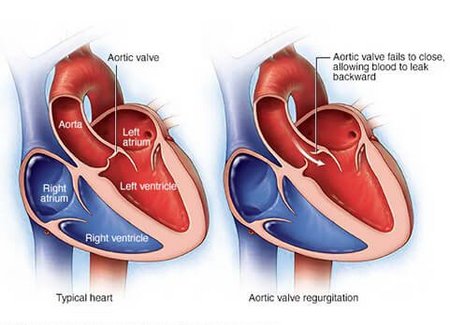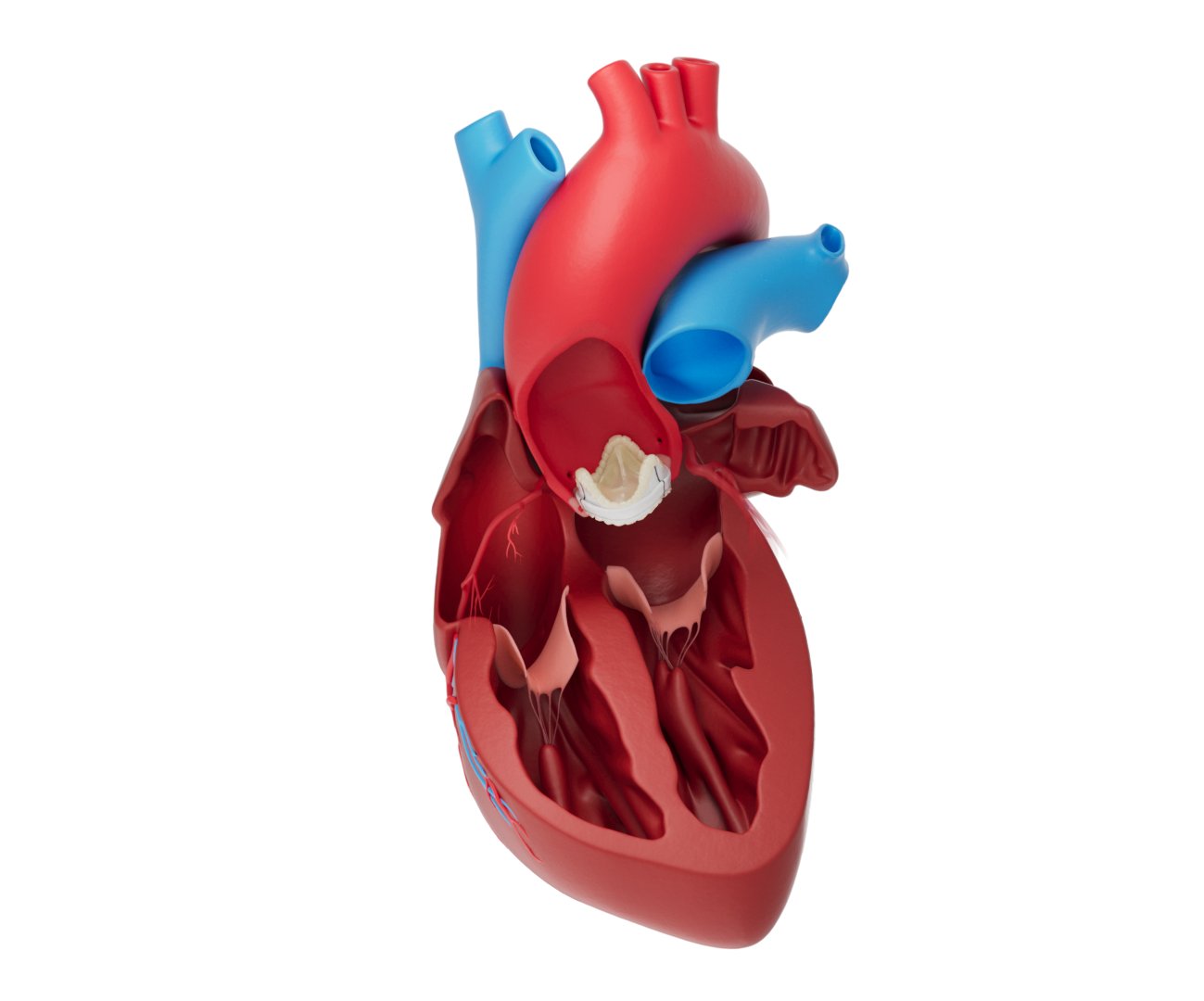Treatment of aortic stenosis
Aortic valve
The aortic valve is a heart valve located between the left ventricle (the heart's main pumping chamber) and the aorta (the body's main artery), ensuring blood flows in one direction from the heart to the aorta.
The aortic valve is vulnerable to disease, particularly as you grow older. It can cause uncomfortable and distressing symptoms, including chest pains, breathlessness and dizziness/blackouts. If untreated, aortic valve problems can result in severe complications, including heart failure, valve infection, life-threatening heart rhythm abnormalities and eventually death.

Aortic valve regurgitation
Aortic valve regurgitation is a heart valve condition where the aortic valve doesn’t close properly, causing blood to leak backwards into the heart’s left ventricle. This can lead to symptoms such as shortness of breath, fatigue, chest pain, palpitations, and swelling in the ankles and feet. Treatment depends on the severity of the condition. Mild cases may only require regular monitoring and medications to manage symptoms or blood pressure. In more severe cases, surgery may be needed to repair or replace the valve, including options like open-heart surgery or minimally invasive procedures such as Transcatheter Aortic Valve Implantation (TAVI)

Aortic valve stenosis
Aortic valve stenosis is one of the most common and serious heart valve diseases. It affects millions of older adults, and that number is increasing. Stenosis is the "abnormal narrowing of a passage in the body". So, aortic stenosis is a condition where the aortic valve narrows, causing the heart muscle to work harder to pump blood to the brain and the rest of the body.
Symptoms
Aortic valve stenosis manifests itself in different symptoms depending on the severity of the disease. As the body's circulation is supplied with less oxygen-rich blood due to the calcification of the aortic valve, your own body's performance decreases with the degree of the disease.
If you experience the following symptoms, you should definitely see a doctor.

The following symptoms may occur:
- Shortness of breath, especially after exertion or when lying down
- Feeling of weakness and exhaustion, especially with increased activity (e.g. climbing stairs)
- Loss of appetite
- Dizziness or even fainting
- Pain in the chest
- Excessive water retention
Symptom Check
Diagnosis

If your physician suspects aortic stenosis, they will first listen to your heart with a stethoscope. When blood flow passes the narrowed valve, the physician can hear an abnormal sound (a murmur).
Echocardiography (ultrasound visualisation of the heart) will be performed to confirm the diagnosis. It can be done by placing a probe on your chest (transthoracic) or inside your oesophagus (transoesophageal). This test can measure the velocity of the blood flow that goes through your aortic valve and help understand the severity of the stenosis. It also provides information about the overall function of your heart and other heart valves.
Sometimes, your physician might recommend stress echocardiography. This test assesses how well your heart functions under stress with physical exercise or medication to increase your heart rate.
Other tests might include an electrocardiogram (ECG), cardiac magnetic resonance imaging (MRI), or computed tomography (X-ray-based imaging) to assess details of your valve size, type, and extent of calcification and determine suitability for different treatment options.
Aortic valve replacement
If severe aortic valve stenosis has been diagnosed, making aortic valve replacement necessary, this should be carried out promptly. Here, too, there are various treatment options available today. Surgical replacement using a heart-lung machine and opening the chest, or the minimally invasive implantation of an aortic valve, known as TAVI. Both procedures have been well studied and there are pros and cons for both. Which procedure is the most suitable for you as a patient will be discussed with you by the heart team. The heart team usually consists of cardiologists, cardiac surgeons, anaesthetists and radiologists. The team discusses individually for each patient which procedure represents the greatest possible success and the lowest surgical risk. The team follows the recommendations of the European Society of Cardiology and UK National Institute for Health and Care Excellence. According to these guidelines, patients over the age of 75 and/or who are not suitable for surgery in particular benefit from the minimally invasive implantation of a transcatheter aortic valve (TAVI).
Navitor™ TAVI System
As shown in the picture, the Navitor™ Vision valve is a wire-frame device with leaflets made of bovine (cow) tissue designed to function like a native aortic valve. The procedure to implant the device inside the heart will take place in a special cardiac suite with your heart team to perform the procedure and care for you.
Your physician will determine the best approach for placing your valve, but using the femoral artery in your leg is the most common. A small incision is made, and the physician uses special X-ray equipment to carefully guide the catheter to the precise location. The Navitor Valve is delivered with a catheter through the sheath and placed within your opened aortic valve.
Your doctor will deploy the valve using special visualisation equipment to ensure the valve is positioned accurately within your heart. Once the device has been positioned correctly, it starts to function immediately. The physician then removes the delivery system catheter, and the small incision is closed. The procedure is complete.

NAVITOR™ TAVI SYSTEM
TAVI | Aortic Valve
The Navitor™ TAVI System offers intelligent design advantages to consistently achieve excellent outcomes across a spectrum of routine to challenging anatomies in patients with severe aortic valve stenosis who are at high or greater risk for surgery.
SURGICAL VALVE REPLACEMENT
What Is the Epic Max Valve and How Can It Help You?
If your aortic valve is damaged or not working properly, your doctor may recommend replacing it. The Epic Max valve is a specially designed heart valve used during surgery to replace a diseased or previously implanted aortic valve.
Why Might You Need It?
You have a damaged or malfunctioning aortic valve that’s affecting how your heart works. You’ve had a valve replacement in the past, and that valve now needs to be replaced again.
What Makes the Epic Max Valve Special?
It’s designed to make it easier for your heart to pump blood, which can help reduce strain on your heart. The valve has a larger opening inside, which helps blood flow more smoothly. It’s built to support future procedures, like transcatheter valve replacement.

MECHANICAL HEART VALVES
The Masters Series and Regent aortic mechanical heart valves have a proven long-term legacy of structural integrity and durability, with unique design features that have established Abbott mechanical heart valves as a gold standard for reliability and performance.
EPIC™ MAX
Epic™ Max is designed to redefine the future of aortic valve lifetime management by providing unparalleled hemodynamics* while maintaining the Epic Platform’s ease of implant, proven durability, and features designed for future intervention.
*Compared to previous Epic Platform iterations.
EPIC™ PLUS SUPRA
The Epic™ Plus Supra aortic valve continues the product family's history of excellence by providing the same trusted durability and performance plus significant enhancements to radiopacity to facilitate future interventions.
After the procedure
After your TAVI procedure, you will be resting in a recovery room. Depending on hospital policy and your status, you might need to stay in intensive care for a short period. The length of stay varies and is determined by your doctor.
Your doctor will decide whether you need to take anticoagulant medication. Please take the medication exactly as prescribed by your doctor. At the follow-up examination, which takes place approximately three weeks after implantation, your doctor may carry out an electrocardiogram, an echocardiogram or a chest X-ray to assess how well your new heart valve is functioning.
9-UK-5-16494-01 08-2025



